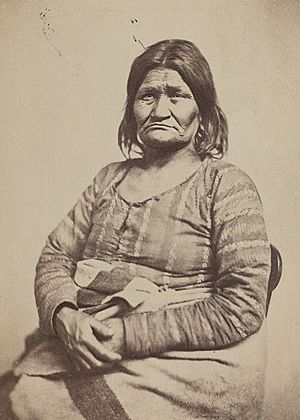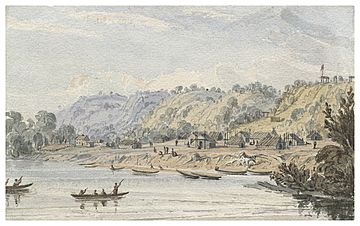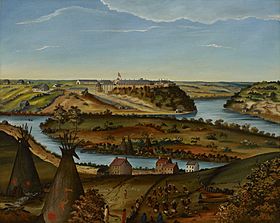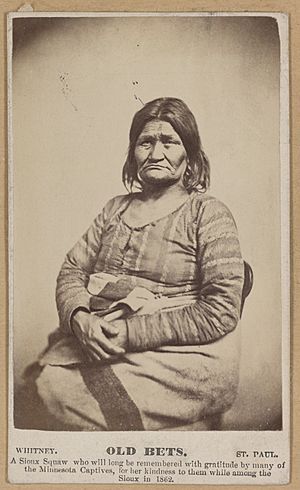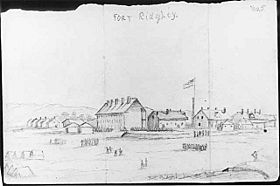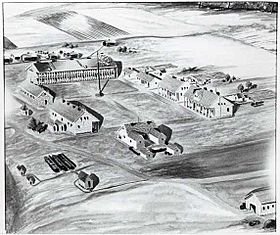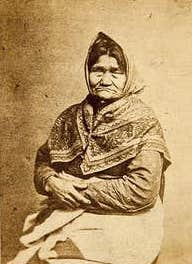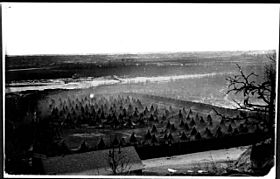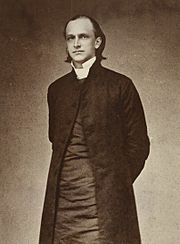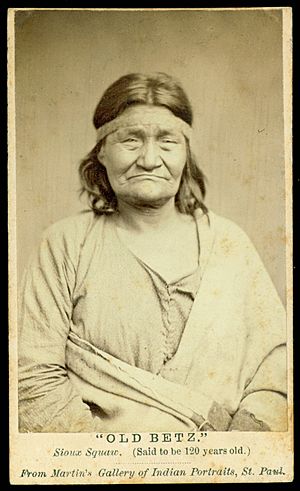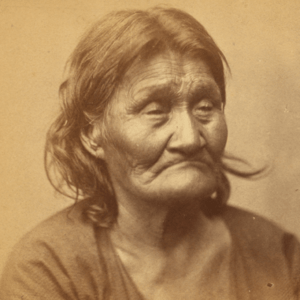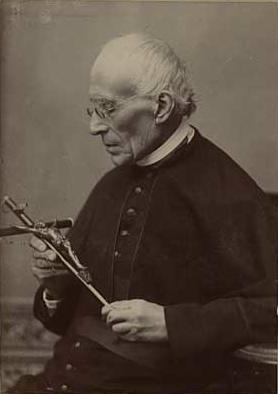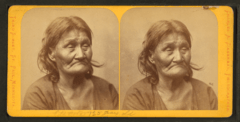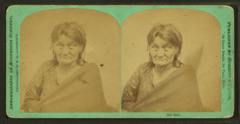Azayamankawin facts for kids
Azayamankawin (born around 1803, died around 1873) was a famous Mdewakanton Dakota woman. She was also known as Hazaiyankawin, Betsey St. Clair, Old Bets, or Old Betz. She became one of the most photographed Native American women in the 1800s. She was well known in Saint Paul, Minnesota, where she once ran a canoe ferry service. People remembered Old Bets for helping many women and children who were captured during the Dakota War of 1862.
Many photos of "Old Betz" were made into small prints called carte-de-visite. These prints are now in museums around the world. You can find them in places like the United States Library of Congress and the Minnesota Historical Society.
Contents
- Early Life and Family
- Her Children
- Role in the Battle of Kaposia
- Canoe Ferry Service
- Growing Popularity in Saint Paul
- Sad Times and Loss
- Moving to the Reservation
- Starting Her Photography Career
- Son Taopi and the Farmer Movement
- Visits to Fort Ridgely
- U.S.–Dakota War of 1862
- Being Held at Fort Snelling
- Moving to Faribault
- Trips to St. Paul
- Moving to Mendota
- Final Years and Death
- Images for kids
Early Life and Family
Betsey’s Dakota name, Azayamankawin, means “Berry Picker.” Another name, Hazaiyankawin, means “Woman Who Runs Toward Huckleberries.” Soldiers at Fort Snelling gave her the name “Betsey” or “Bets.”
Azayamankawin was born around 1803. She likely grew up in the Mdewakanton Dakota village of Kaposia. This village was located near where St. Paul is today.
Her mother was Itahotawin, whose name means “Grey Face Woman.” Azayamankawin had at least five brothers and sisters. Her brother Ticawakeya was known as “One-Legged Jim.” Her other brothers were Hinhdaku, a medicine man, and Kahdaya, a leader called “Rattler.” Her sisters were Pahadutawin and Huntka, who was known as “Ellen.”
Working as a Nurse
Azayamankawin said she was a teenager when American soldiers arrived in Mendota in 1819. She worked as a nurse for a military family. A baby was born on Pike Island, and "Young Bets" helped care for the mother and child. She was known for being kind and helpful. The family always remembered her with warmth and thanks.
Her Children
Azayamankawin may have had as many as twelve children. Her most famous son was Taopi, which means "Wounded Man." He was born around 1824.
Other important sons included Wakandikaga, also known as Job St. Clair. There was also Wicahnhpihiyaye, or "Shooting Star," and Ruyapaduta, or "Scarlet Wing." Her confirmed daughters were Dutawin ("Scarlet Woman") and Pazutawin. Another possible daughter was Anpahdiwin, later known as Nancy St. Clair.
Role in the Battle of Kaposia
On June 25, 1842, a group of Ojibwe men came to attack Kaposia. This was a revenge raid. The Ojibwe met two Dakota women working on a farm. Betsey was nearby with one of her brothers.
She heard shots and quickly waved a blanket. This was a signal to warn the villagers across the river. The Dakota warriors rushed over in their canoes. A battle started, and the Ojibwe eventually left.
Many Dakota were hurt or killed. Betsey’s son Taopi was badly wounded in this battle. He survived, but the injuries made him even more famous as "Wounded Man."
Canoe Ferry Service
In the early 1850s, Betsey often used her canoe to ferry people across the Mississippi River. She was very skilled at navigating the water.
In 1839, an Indian agent noted that Betsey had a canoe belonging to someone else. She refused to return it unless she was paid.
In 1850, Betsey even put an advertisement in a newspaper. She announced that she had a license from Chief Little Crow to run a ferry. She said she would carry passengers for the usual price, and more if people wanted to give it. She was competing with another ferry service.
Also in 1850, Betsey saved two white men whose canoe had flipped over. The men were struggling in the water. Betsey and a boy, possibly her grandson, quickly paddled over. They saved the men just as they were about to drown.
Growing Popularity in Saint Paul
During the 1840s, more white settlers moved to the Saint Paul area. Old Bets became a well-known person in St. Paul and Mendota. Newspapers often wrote about her. She was known for being good at business, asking for money, and selling goods. She was one of the few Dakota women invited into settler homes to help with chores.
She was very outgoing, which was unusual for Dakota women around white people. Betsey was also very hardworking. She was direct when asking for money or other items.
Her Reputation for Asking for Money
Betsey was very open about asking strangers and friends for money. She often asked for “kashpapi,” which meant a ten-cent coin. A historian named J. Fletcher Williams wrote that she was like a local landmark. She would always get food from the kitchens of old settlers. She was a special person, and no old settler would refuse her request for money. She would greet people with a big smile and a cheerful "ho-ho."
Harriet E. Bishop, a schoolteacher, wrote about Betsey. She called her an "incorrigible beggar." Once, Betsey gave Bishop a ride in her canoe. Bishop didn't have money, so a reverend paid for her. Bishop thought the debt was settled. But a few days later, Betsey came to her house to demand full payment. Bishop paid her. Betsey even asked Bishop for money two more times, claiming she had hurt her arm.
However, Betsey often asked for help for others. She was known to share what she received with other Dakota people. She often gave away more than she kept, following Dakota customs. Later in her life, Henry Hastings Sibley noticed that she would quickly give away anything he gave her.
Sad Times and Loss
Old Bets went through many sad events in her life. People often noticed her pain when she was in mourning. In 1850, at least three of her close family members died. Her brother Rattler died, and her brother Hinhdaku was killed. One of her sons also died in an attack. In 1853, Betsey’s sister was badly hurt in St. Paul.
Son's Death in Ojibwe Attack
On May 15, 1850, one of Betsey’s sons was killed by Ojibwe warriors. This was a revenge attack. Chief Hole-in-the-Day the Younger attacked a group of Dakota below Mendota.
The Dakota brought Betsey’s son’s body back by canoe. As they carried his coffin, Harriet Bishop saw Betsey showing her deep sadness. She cut and hurt herself as a sign of mourning.
Moving to the Reservation
In October 1853, Betsey and her family moved to new reservation lands. These lands were along the Minnesota River. They were among 2,300 Mdewakanton and Wahpekute Dakotas who had to leave their villages. This was part of the 1851 Treaty of Mendota with the United States. However, the reservation was not ready for them. They lacked food and proper buildings.
Back in St. Paul, people missed Betsey and her brother Jim. An editor wrote that they were sad to see them go.
Seasonal Travels
The Dakota received yearly payments for giving up their land. At first, this was cash, not food. Many could not buy enough food for the winter. After getting their payments, most Dakota groups would go to a campground for the winter.
In May 1854, Betsey visited St. Paul with chiefs Little Crow III and Shakopee II. A newspaper said she was as famous as the chiefs. Betsey told a reporter she was now "white" and living like a white person. She had started trading goods with western Dakota tribes for horses or buffalo skins.
The reservation had problems with farming and food. Agents failed to order seeds, and food spoiled. The Dakota had to find food for themselves. They often went to white settlements to ask for or trade food. They would also hunt deer in the "Big Woods."
Starting Her Photography Career
By 1859, Betsey’s son Lightning Maker had moved to Faribault. Betsey started visiting Faribault more often, asking for food. She would then walk to St. Paul before returning to the reservation, traveling hundreds of miles.
During these visits to St. Paul, Betsey was first asked to pose for photos at Joel Whitney’s studio. By this time, Dakota people were rarely seen in St. Paul. Betsey was probably seen more often than any other Dakota. Whitney likely paid her to sit for her portrait. He displayed her photos and sold them as cartes-de-visite starting in 1861.
Her portrait was even mentioned in a New York photography journal in 1862. The journal noted that "Old Bet" was "not at all ornamental" compared to a "Dacotah Dandy."
People started to think of Old Bets as "the ancient Dakota." When she was away, people in St. Paul would wonder if she had died. When she returned, newspapers would report, "She ain’t dead yet." People thought she must be very old because of her appearance, especially when she was in mourning. Betsey herself sometimes said she was very old.
Son Taopi and the Farmer Movement
In 1858, Betsey’s son Taopi joined the "farmer band" of Dakota at the Redwood Agency. In 1860, a bishop named Henry Benjamin Whipple convinced Taopi to cut his hair.
In May 1861, the new Indian agent, Thomas Galbraith, made Taopi "chief of farmers." He promised him a salary. Taopi was likely suggested for the job by his friend, trader William Henry Forbes.
As head of the farmers, Taopi was in the middle of a big disagreement among the Mdewakanton Dakota. There were "farmers" who had cut their hair and become Christian, and "hunters" who followed older traditions. People became angry with the government farming program. Funds meant for the Dakota were being stolen by Indian agents and traders.
In June 1862, two of Taopi’s children died. Betsey was sad for her grandchildren. Some traditional Dakota said Taopi was being punished for becoming Christian. But Taopi was still baptized in August 1862.
Visits to Fort Ridgely
Betsey often visited Fort Ridgely to find food after the fort was built in 1854. There are stories about her interactions with soldiers and their families there.
A soldier named Oscar G. Wall described Betsey picking food from a barrel outside the kitchen. She would put vegetables and old bread into her skirt, using it like a basket. Soldiers were usually kind to her, but sometimes teased her because she could be "cross and irritable." She might throw a cold potato at them and say, "Se-chee," meaning "Bad." Wall described her as "Old Betz, a squaw everywhere renowned for her great age."
In 1861, about 100 soldiers were at Fort Ridgely. Few had their families with them. Stories show how soldiers' wives and "Old Betts" sometimes misunderstood each other.
One woman wanted a piece of Betsey's hair to show her mother. She tried to cut it, and Betsey "jumped away screaming." Later, the woman held a mirror up to Betsey's face. Many Dakota women believed looking in a mirror could cause death. Betsey became very angry and tried to break the glass.
Another woman recalled trading with Betsey for moccasins. She promised Betsey a piece of pork and some sugar. When Betsey brought the moccasins, the woman gave her a different, larger piece of pork. Betsey got very angry, saying "Cheatey Squaw." The woman gave her more sugar, and Betsey left. Later, when the woman mentioned it, Betsey pulled out a knife and chased her. After this, Betsey was not allowed on the reservation.
In early August 1862, a large group of Dakota visited Fort Ridgely. They performed dances to ask for money from the soldiers. Betsey was present during these dances.
U.S.–Dakota War of 1862
One important thing about Old Bets is that people remembered her kindness to white captives during the Dakota War of 1862. The war began on August 18. Little Crow and his followers took many white and mixed-blood women and children captive. Some hostages were later taken in by Dakota families who tried to protect them.
While Taopi's role in saving hostages is well known, Betsey's specific actions are not fully written down. However, Betsey’s sister-in-law, Hazatonwin, was known for protecting a family and making sure they had food.
Taopi and the Peace Coalition
After a battle, Taopi, Good Thunder, and Chief Wabasha secretly sent a letter to Colonel Henry Hastings Sibley. They told him they were against Little Crow and wanted to help the white people. Sibley wrote back, telling them to wait for him and save as many prisoners as they could.
One male hostage, George Spencer, said Taopi would save them. Taopi said the captives "came flocking to our tepees like pigeons." He then shared the captives among his friends. It is thought that some of these captives found shelter with his mother, Betsey.
While Chief Little Crow and his men were fighting, Taopi and others stayed behind. They rescued the captives and told them to dig trenches for safety. Taopi sent another message to Sibley, urging him to come quickly.
Camp Release
On September 26, 1862, the "peaceful" Dakota released 241 captives to Colonel Henry Hastings Sibley. This happened at their camp, known as Camp Release. Many stories mention "Old Betz" being there, watching the soldiers during the handover.
A U.S. veteran, Thomas Watts, said Betsey was easy to recognize. She was allowed to move freely around their camp. He wrote that she was kind to the white women and children who had been captured. She could speak some English, enough to be understood.
Trials
People often said Betsey testified against Dakota men accused of crimes during the war. However, her name does not appear in any trial records as a witness. Her son Taopi did testify for and against members of his group.
On October 29, Betsey’s son Shooting Star was tried. He said he only joined the attack because his family was threatened. He also said he did not want to shoot his gun because his brother lived nearby. It is not known what happened to Shooting Star after the trials.
Being Held at Fort Snelling
On November 7, 1,658 Dakota non-fighters, mostly women and children, were sent to a camp at Fort Snelling. This group included Betsey, her mother, her sister Ellen, and her daughters.
Harriet Bishop McConkey visited the camp. Many people visited daily to see the hundreds of tepees inside a fence. The fence was there to protect the Dakota from angry settlers, and to keep them inside.
Bishop McConkey described seeing Betsey there. She said Betsey was seen in every photo gallery and recognized by everyone. She had many friends, and was proud that no one in her family had fought against the white people. Bishop McConkey was surprised when Betsey kissed her hand goodbye.
Son-in-law's Conviction and Pardon
Betsey’s son-in-law, Round Wind, was one of 39 men sentenced to death. A boy had said Round Wind killed his mother. Round Wind was baptized and told his family not to mourn him. He believed he would be "saved" because he had not killed any white people. On December 25, General Sibley pardoned Round Wind at the last minute. This was because of his age and new evidence that the real killers had escaped.
Moving to Faribault
In May 1863, 1,318 Dakota who had been held at Fort Snelling were sent out of Minnesota. They traveled on steamships to the Crow Creek Reservation. Taopi was one of the few Dakota men allowed to stay in Minnesota with their families. Taopi asked if his mother, Betsey, could stay with him. General Henry Hastings Sibley agreed.
However, Betsey’s mother, Grey Face Woman, was sent away. She was among 300 women and children who died on the steamship. The ships were crowded, with little food and much illness. Grey Face Woman's death was wrongly reported as Betsey's death in St. Paul newspapers. This was the first of many times Betsey's death was reported too soon.
Bishop Henry Benjamin Whipple helped Taopi's family and others who stayed behind. Sibley wanted to send them to the Missouri River because Minnesotans did not want any Dakota to stay. Whipple found a way to help. He asked trader Alexander Faribault for help. Faribault offered some of his land for an Indian camp.
Some people in Faribault did not want the Dakota living among them. But Alexander Faribault wrote to the local newspaper, saying he was not hiding "guilty Indians." Life in Faribault was hard for the Dakota. They often relied on help from Whipple and Faribault.
They tried to farm, but a flood in 1865 ruined their crops. The Dakota then started digging ginseng. They sold it to a buyer in Faribault, who sent it to China.
Trips to St. Paul
Two weeks after two Dakota leaders were executed in November 1865, Old Bets arrived in St. Paul. She received a warm welcome. Local newspapers celebrated her return after two and a half years.
She continued to be very popular for photos. Photographers in St. Paul wanted to sell "Old Betz" carte-de-visite prints. Joel Whitney, who started the trend, and others like William H. Illingworth and Charles A. Zimmerman, sold her portraits.
In 1866, Whitney said he had sold tens of thousands of Betsey's photos, even to collectors in Europe. Many photo cards said she was a "Sioux squaw" and "120 years old." Photos from this time show she had lost most of her teeth, making her look older. Many captions mentioned her kindness during the Dakota War of 1862.
In summer 1868, Betsey often visited St. Paul. She camped in Mendota for months. She sold wild fruit and other items to her friends. Betsey also went house to house in St. Paul, asking for food. People were usually very kind to her. She was often seen carrying large bags of food back to her camp.
Betsey became even more famous as books were published featuring her name and image. Colonel C. Hankins wrote a whole chapter about "Betsey" in his 1868 book.
Once, she visited Harriet Bishop at her home. Bishop showed Betsey her portrait in a new book. Betsey made funny faces and messed up her hair, as if to say she looked that way in the picture. She made a sound and said, "Ah, too bad! Too bad!"
Betsey returned to Faribault, but her family struggled that winter. Taopi’s health was getting worse from tuberculosis. Betsey still appeared in St. Paul in January 1869 looking for food. Taopi himself went hunting despite his illness.
Taopi died from tuberculosis on February 18, 1869.
Moving to Mendota
In 1869, Betsey and about twenty other Dakota people moved from Faribault to Mendota. This group included three of her daughters, Lightning Maker and his family, and other relatives.
In July 1869, Betsey visited Harriet Bishop again. Bishop wrote that Betsey cried and said, "Me pappoose dead! Me pappoose dead… Taopi – aye, aye, Taopi, dead." Bishop was moved by Betsey’s sadness. She wrote an article saying that Betsey, as an old woman, was a gift to the community. She deserved help in her final years.
Betsey and her relatives moved onto land owned by Henry Hastings Sibley. Their camp in Mendota became a tourist spot. In 1873, a newspaper wrote that hundreds of tourists visited each summer. They wanted to see Indian life without danger.
Betsey and her family did many things to survive. Lightning Maker hunted. The women made moccasins and mittens to sell. They dug ginseng, planted crops on Sibley’s land, and gathered wild rice. Betsey continued to go to St. Paul to trade and ask for food and money. By the 1870s, she was seen walking with a cane. People said she was proud of her fame and used it to ask tourists for money. She was still sought after for photographs, even more than famous Dakota chiefs.
Around 1870, an artist named Andrew Falkenshield painted a picture of Betsey. It is not known if she posed for it. This painting is now at the Minnesota Historical Society.
Betsey became so famous that in January 1871, a song called “Old Betz Song” was published.
Final Years and Death
In fall 1871, Betsey was sick. People thought she was dying. She asked for Father Augustin Ravoux for spiritual help. Father Ravoux suggested she be baptized. On October 8, 1871, Betsey was baptized at the Catholic Church of St. Peter's in Mendota. Her name was recorded as “Betsey Mary St. Clair.” This was the only time she used the last name “St. Clair.”
Soon after, several newspapers in St. Paul published obituaries for her. Later, when it was clear Betsey was still alive, the newspapers were made fun of for their mistake. In October 1871, Father Ravoux visited Betsey again and thought she was near death. He told his contacts, who published another "almost obituary." In March 1872, another early obituary was published in Harper's Weekly in New York City.
Henry Hastings Sibley spoke about Betsey’s worsening health in July 1872. She was so sick with rheumatism that she could not leave her home. She was sad she could no longer earn a living. Sibley had helped her for years but was struggling to continue. He asked for donations and collected money for her.
On April 26, 1873, a reporter said Betsey had finally died. The St. Paul Dispatch was careful not to be wrong again. They sent a reporter to check the news. The Pioneer was also doubtful but finally published her obituary on May 1, 1873. Historians at the time believed she had died. However, some think Betsey might have lived for another 10 years, based on a list of Dakota people receiving payments in 1885. Her final resting place is not known.
Images for kids
- Stereoscopic views
-
Old Bets, a Sioux squaw 120 years old, will long be remembered with gratitude by many of the Minnesota captives, for her kindness to them while among the Sioux in 1862, by Whitney's Gallery.jpg
"Old Bets, a Sioux squaw"
by Joel E. Whitney


